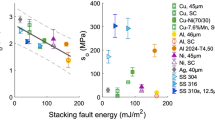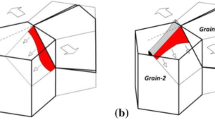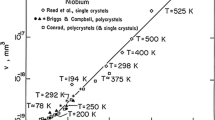Abstract
A novel theory is presented for work hardening in stage II shown by single crystals of ductile face-centered cubic (fcc) metals. The theory is based on the assumption that slipbands are highly elongated ellipsoidal zones with weak interiors, oriented at small, alternating angles with the crystallographic slip planes. Consideration of the stacking of such ellipsoids, together with a condition for the nucleation of a new slipband at the center of an obstacle nearby, yields both the average angle of inclination and the shear offset in the bands, both of which remain constant throughout stage II. The theory makes several predictions concerning the internal stress distribution and the plastic behavior. Before expounding the theory, the concepts upon which it is based are discussed in the context of two much simpler problems: the work hardening of dispersionhardened metals and the cyclic work hardening which forms the basis of understanding fatigue properties. The picture confirms in a natural way that the value of σ III , the stress which marks the end of stage II hardening, may be taken to be equal to the fatigue endurance limit.
Similar content being viewed by others
References
Doris Kuhlmann-Wilsdorf:Metall. Trans. A, 1985, vol. 16A, pp. 2091–2108.
M.F. Ashby: inStrengthening Methods in Crystals, A. Kelly and R.B. Nicholson, eds., Elsevier, New York, NY, 1971, pp. 137–92.
J.D. Eshelby:Proc. R. Soc., 1957, vol. A241, p. 376.
J.D. Eshelby:Proc. R. Soc., 1959, vol. A252, p. 561.
L.M. Bown and D.R. Clarke:Acta Metall., 1975, vol. 23, p. 821.
P.J. Withers, W.M. Stobbs, and O.B. Pedersen:Acta Metall., 1989, vol. 37, p. 3061.
L.M. Brown and W.M. Stobbs:Phil. Mag., 1976, vol. 34, p. 351.
O.B. Pedersen, L.M. Brown, and W.M. Stobbs:Acta Metall., 1981, vol. 29, p. 1843.
O.B. Pedersen:Acta Metall., 1983, vol. 31, p. 1795.
L.M. Brown: inFundamentals of Deformation and Fracture, B. A. Bilby, K.J. Miller, and J.R. Willis, eds., Eshelby Memorial Symposium, Cambridge University Press, New York, NY, 1985, pp. 357–67.
Z.S. Basinski, A.S. Korbel, and S.J. Basinski:Acta Metall., 1980, vol. 28, p. 191.
R. Kwadjo and L.M. Brown:Acta Metall., 1978, vol. 26, p. 1117.
N. Y. Jin and A.T. Winter: inBasic Questions in Fatigue, ASTM STP 924, J.T. Fong and R.J. Fields, eds., ASTM, Philadelphia, PA, 1988, vol. 1, p. 17.
L.M. Brown: inDislocation Modelling of Physical Systems, M. F. Ashby, R.K. Bullough, C.S. Hartley, and J.P. Hirth, eds., Pergamon Press, New York, NY, 1981, pp. 51–68.
L.M. Brown and S.L. Ogin: inFundamentals of Deformation and Fracture, B.A. Bilby, K.J. Miller, and J.R. Willis, eds., Cambridge University Press, New York, NY, 1985, pp. 501–28.
L.M. Brown:The Modelling of Material Behaviour and Its Relation to Design, Ashby Symposium, J. D. Embury and A.W. Thompson, eds., TMS, Warrendale, PA, 1990, pp. 175–98.
S. Mader:Z. Physik, 1957, vol. 149, p. 73.
H. Mughrabi, F. Ackermann, and K. Herz: inFatigue Mechanisms, ASTM-NBS-NSF Symposium, J.T. Fong, ed., 1979.
P. Neumann:Z. Metallkd., 1968, vol. 59, p. 927.
S.J. Basinski and Z.S. Basinski: inDislocations in Solids, F. R. N. Nabarro, ed., North-Holland Publishing Company, Amsterdam, The Netherlands, 1979, ch. 16.
P.J. Jackson:Acta Metall., 1985, vol. 33, p. 449.
J.G. Antonopoulos, L.M. Brown, and A.T. Winter:Phil. Mag., 1976, vol. 34, p. 549.
R. Wang, H. Mughrabi, S. McGovern, and M. Rapp:Mater. Sci. Eng., 1984, vol. 65, p. 219.
M.J. Whelan:Proc. R. Soc., 1958, vol. A249, p. 114.
H.D. Nine and D. Kuhlmann-Wilsdorf:Can. J. Phys., 1967, vol. 45, p. 865.
G. Saada:Acta Metall., 1960, vol. 8, p. 200 ; 1961, vol. 9, p. 166.
D. Kuhlmann-Wilsdorf and N.R. Comins:Mater. Sci. Eng., 1983, vol. 60, pp. 7–24.
P.B. Hirsch and T.E. Mitchell:Can. J. Phys., 1967, vol. 45, p. 663.
O.B. Pedersen:Acta Metall., 1987, vol. 35, p. 2567.
See J.M. Ziman:Models of Disorder, Cambridge University Press, New York, NY, 1979, which refers to Bernai and discusses the two-dimensional analogue on pp. 77-87. Note that the construc- tion of Fig. 11 does not require mechanical stability under inter- nal and external forces; it is merely a geometrical construction.
U.F. Kocks: inDislocations and Properties of Real Materials, Institute of Metals, London, 1985.
L.M. Brown, J.R. Dryden, P. Perovic, and G.R. Purdy:Metall. Trans. A, 1991, vol. 22A, pp. 1159–64.
J.W. Steeds:Proc. R. Soc., 1966, vol. A292, pp. 343–73.
Rights and permissions
About this article
Cite this article
Brown, L.M., Medalist, R.F.M. Toward A Sound Understanding of Dislocation Plasticity. Metall Trans A 22, 1693–1708 (1991). https://doi.org/10.1007/BF02646493
Issue Date:
DOI: https://doi.org/10.1007/BF02646493




